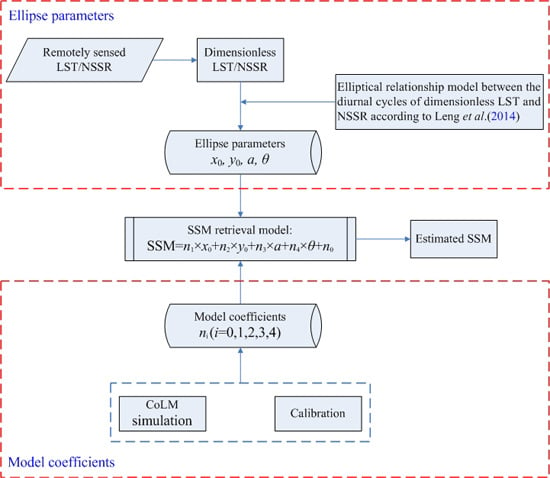Toward the Estimation of Surface Soil Moisture Content Using Geostationary Satellite Data over Sparsely Vegetated Area
Abstract
:1. Introduction
2. Study Area and Dataset
2.1. FLUXNET Meteorological Data
| Site | Soil Texture | Latitude, Longitude | Land Use | Climate Type |
|---|---|---|---|---|
| Bondville | Silty Loam | 44.0062°N, −88.2904°W | cropland | temperate continental |
| Audubon Research Ranch | Sandy Loam | 31.5907°N, −110.5092°W | desert grassland | temperate arid |
| Brookings | Clay Loam | 44.3453°N, −96.8362°W | range grassland | humid continental |
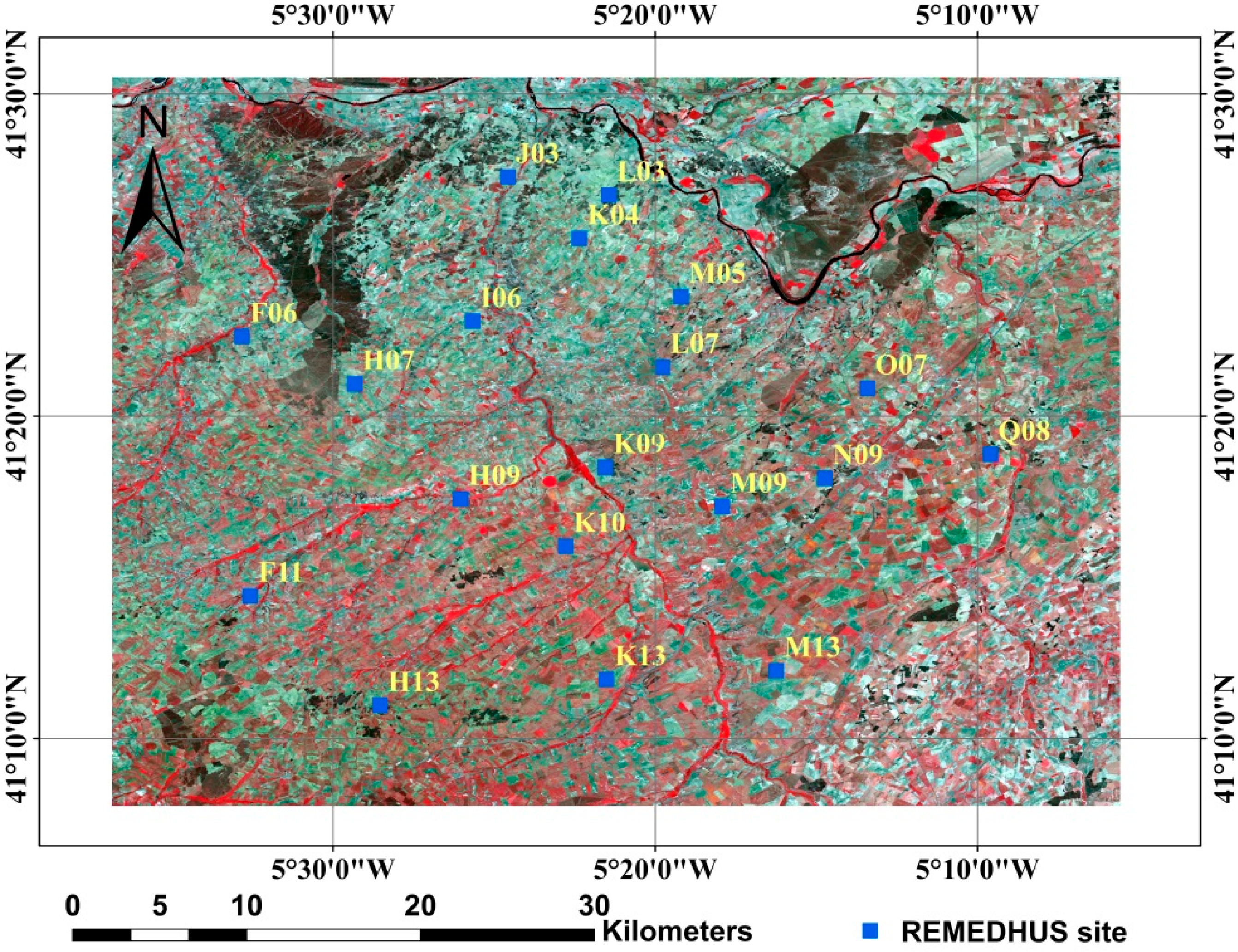
2.2. REMEDHUS Soil Moisture Network
| Site | Sand (%) | Silt (%) | Clay (%) | Latitude, Longitude | Line, Sample |
|---|---|---|---|---|---|
| F06 | 67.19 | 13.70 | 19.11 | 41.37455°N, −5.54714°W | 476, 160 |
| F11 | 81.52 | 11.97 | 6.51 | 41.24040°N, −5.54291°W | 479, 160 |
| H07 | 85.10 | 9.64 | 5.26 | 41.35004°N, −5.48891°W | 477, 162 |
| H09 | 19.78 | 44.99 | 35.23 | 41.29050°N, −5.43402°W | 478, 163 |
| H13 | 70.36 | 11.45 | 18.19 | 41.18381°N, −5.47572°W | 481, 162 |
| I06 | 89.81 | 5.93 | 4.26 | 41.38251°N, −5.42786°W | 476, 163 |
| J03 | 85.05 | 11.26 | 3.69 | 41.45703°N, −5.40964°W | 474, 164 |
| K04 | 87.09 | 9.27 | 3.64 | 41.42529°N, −5.37267°W | 475, 165 |
| K09 | 74.36 | 15.00 | 10.64 | 41.30690°N, −5.35925°W | 478, 165 |
| K10 | 91.16 | 5.71 | 3.13 | 41.26611°N, −5.37972°W | 479, 164 |
| K13 | 62.22 | 18.21 | 19.57 | 41.19720°N, −5.35861°W | 480, 165 |
| L03 | 82.25 | 6.44 | 11.31 | 41.44765°N, −5.35734°W | 474, 165 |
| L07 | 46.80 | 20.78 | 32.42 | 41.35873°N, −5.32977°W | 476, 166 |
| M05 | 81.64 | 8.31 | 10.05 | 41.39508°N, −5.32010°W | 476, 166 |
| M09 | 49.83 | 24.89 | 25.28 | 41.28662°N, −5.29868°W | 478, 167 |
| M13 | 3.57 | 32.04 | 64.39 | 41.20170°N, −5.27085°W | 480, 167 |
| N09 | 62.46 | 16.78 | 20.76 | 41.30126°N, −5.24569°W | 478, 168 |
| O07 | 78.84 | 13.47 | 7.69 | 41.34778°N, −5.22361°W | 477, 169 |
| Q08 | 86.07 | 5.68 | 8.25 | 41.31359°N, −5.16005°W | 477, 170 |
2.3. Satellite Observations
3. Methodology
3.1. Overview of the Previous Bare Surface Soil Moisture (SSM) Retrieval Model
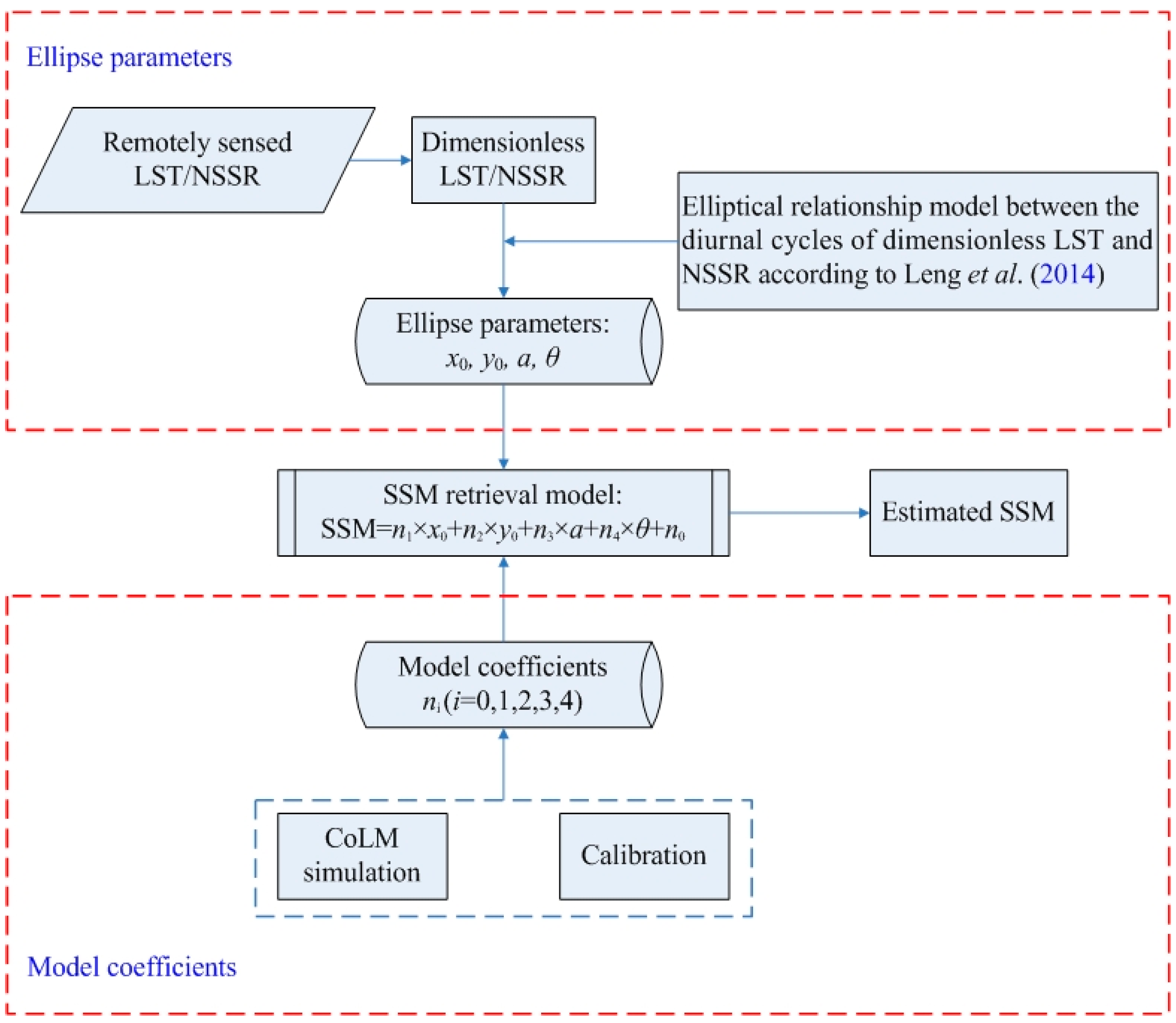
3.2. Land Surface Model Simulation
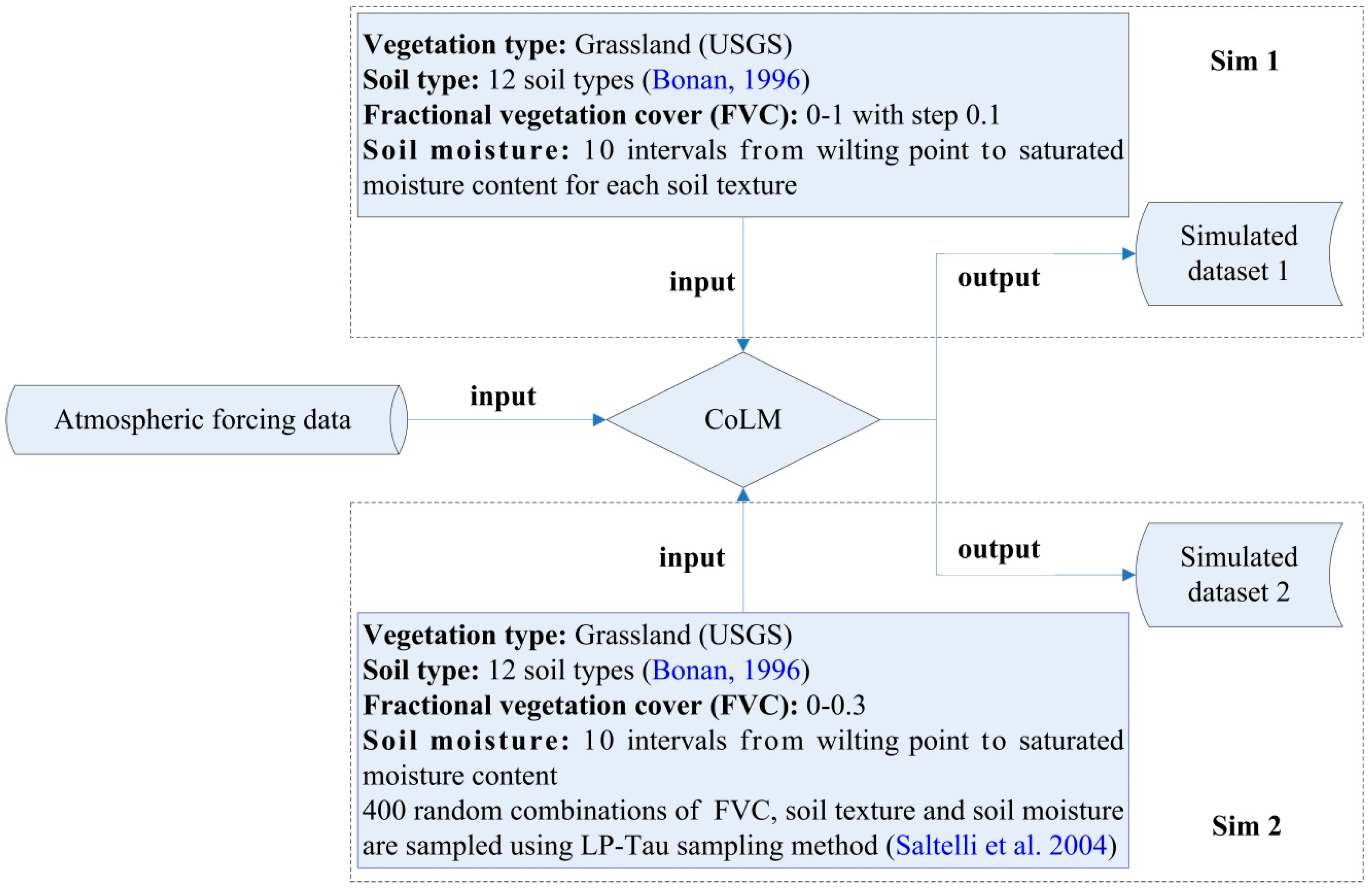
| No. | Sand (%) | Silt (%) | Clay (%) | Soil Textures | Range of SSM (m3·m−3) |
|---|---|---|---|---|---|
| 1 | 92 | 5 | 3 | Sand | 0.010–0.339 |
| 2 | 82 | 12 | 6 | Loamy Sand | 0.028–0.421 |
| 3 | 58 | 32 | 10 | Sandy Loam | 0.047–0.434 |
| 4 | 17 | 70 | 13 | Silt Loam | 0.084–0.476 |
| 5 | 10 | 85 | 5 | Silt | 0.084–0.476 |
| 6 | 43 | 39 | 18 | Loam | 0.066–0.439 |
| 7 | 58 | 15 | 27 | Sandy Clay Loam | 0.067–0.404 |
| 8 | 10 | 56 | 34 | Silty Clay Loam | 0.120–0.464 |
| 9 | 32 | 34 | 34 | Clay Loam | 0.103–0.465 |
| 10 | 52 | 6 | 42 | Sandy Clay | 0.100–0.406 |
| 11 | 6 | 47 | 47 | Silty Clay | 0.126–0.468 |
| 12 | 22 | 20 | 58 | Clay | 0.138–0.468 |
4. Results and Discussion
4.1. Effect of Vegetation on the Bare SSM Retrieval Model
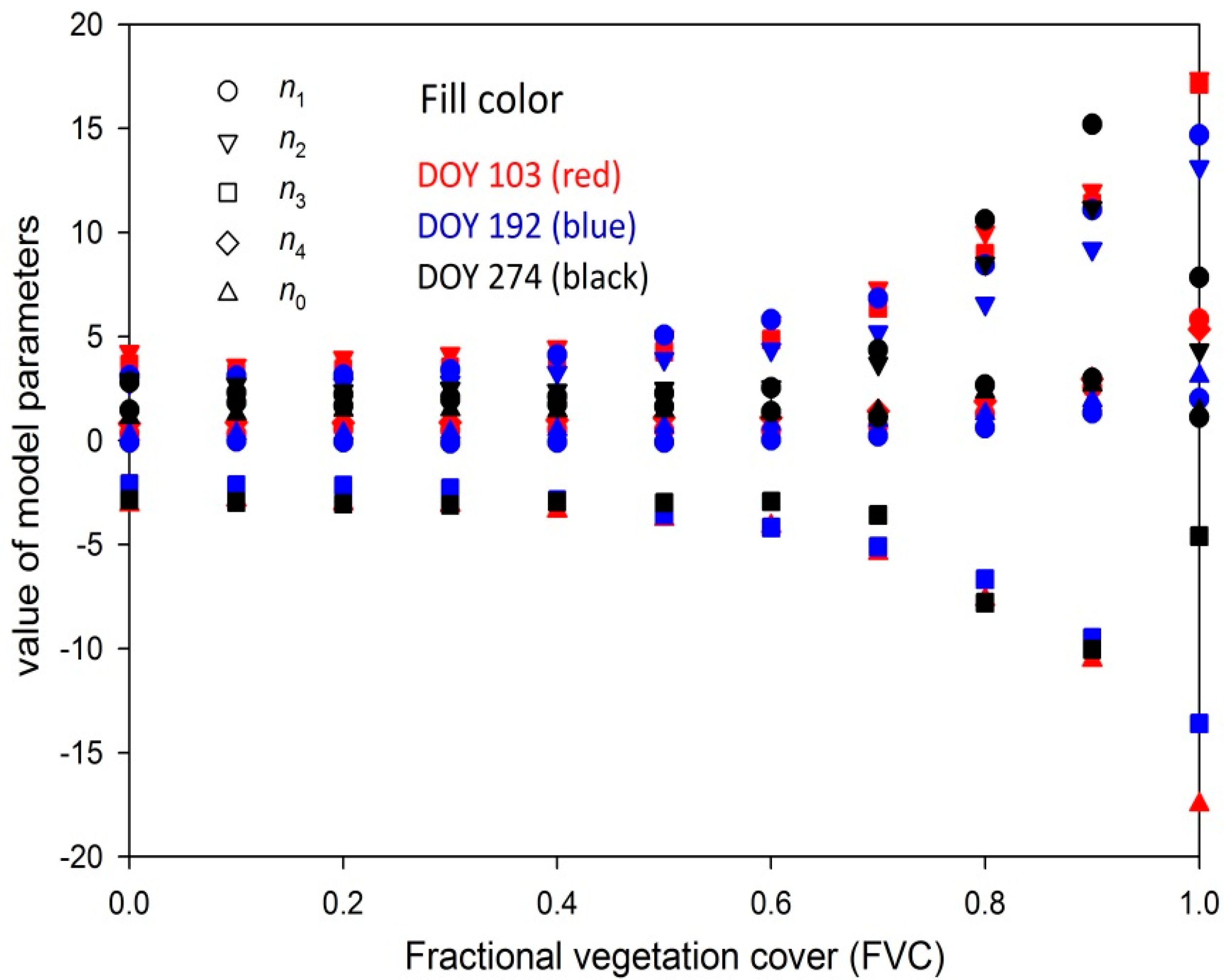
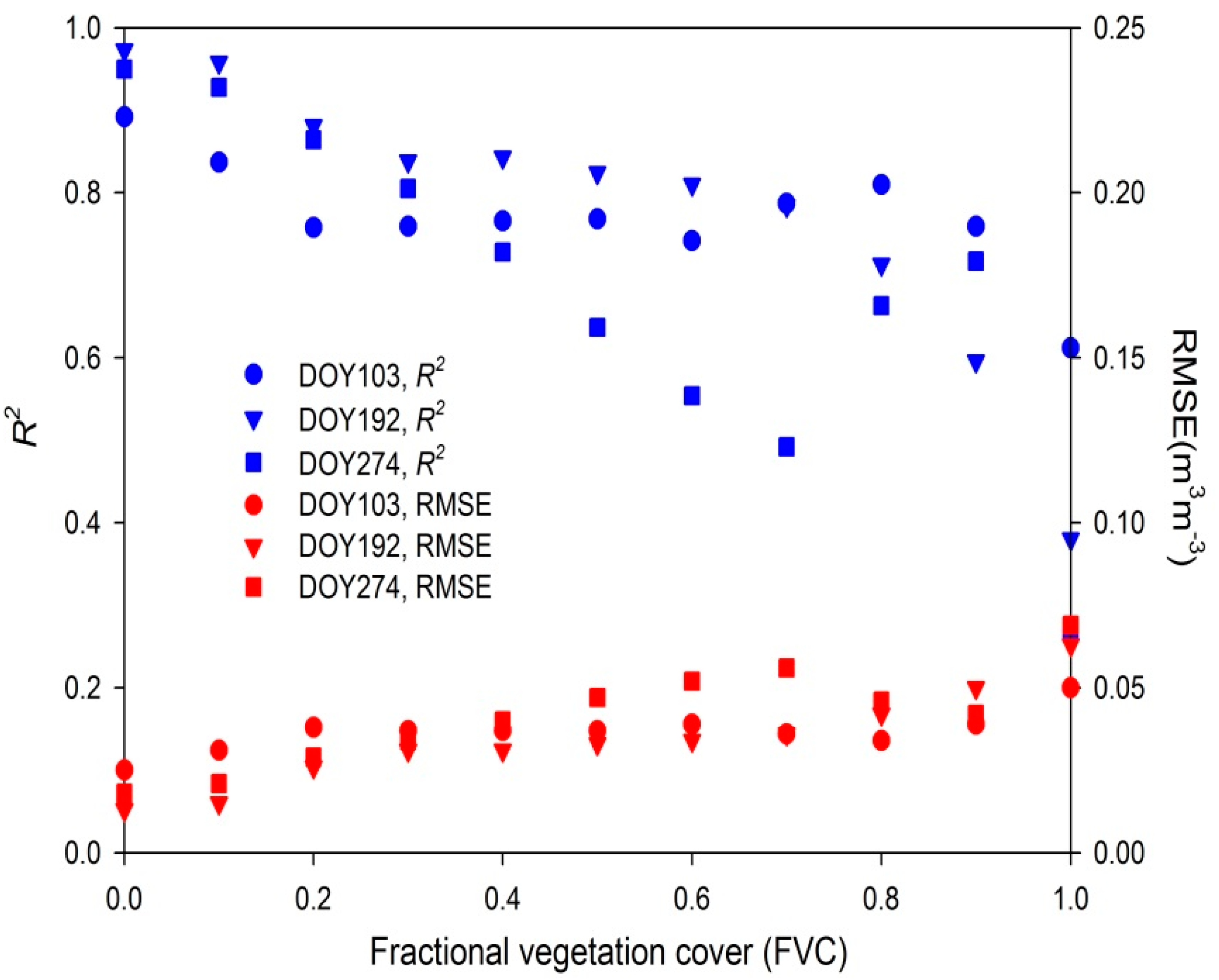
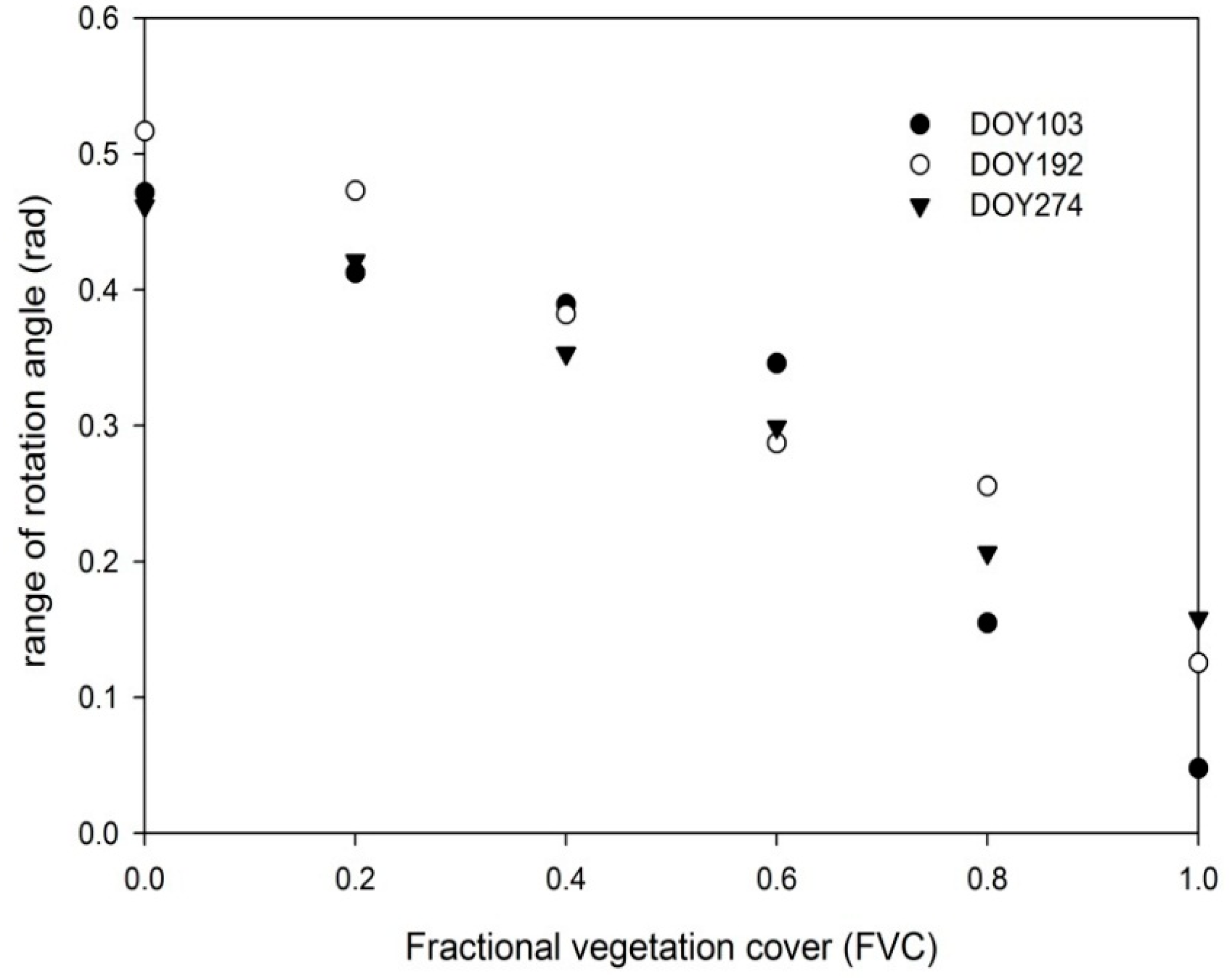
4.2. Feasibility of the SSM Retrieval Model in Sparsely Vegetated Conditions
| DOY | n1 | n2 | n3 | n4 | n0 | R2 | RMSE (m3·m−3) |
|---|---|---|---|---|---|---|---|
| 103 | 0.182 | 3.689 | 3.278 | 0.768 | −2.723 | 0.855 | 0.027 |
| 128 | −0.451 | 3.692 | 3.063 | 0.262 | −1.910 | 0.792 | 0.032 |
| 167 | −0.188 | 3.519 | 2.933 | 0.218 | −1.918 | 0.957 | 0.015 |
| 192 | −0.140 | 3.083 | 2.797 | 0.272 | −2.026 | 0.970 | 0.012 |
| 216 | −0.258 | 3.199 | 2.495 | 0.384 | −1.923 | 0.807 | 0.032 |
| 248 | 0.183 | 3.590 | 2.834 | 0.793 | −2.597 | 0.789 | 0.033 |
| 274 | 0.667 | 3.016 | 2.711 | 0.864 | −2.330 | 0.917 | 0.021 |
| 298 | 0.113 | 4.972 | 3.982 | 0.422 | −2.212 | 0.925 | 0.020 |
| Mean | 0.876 | 0.025 |

4.3. Determination of Model Coefficients from Satellite Observations and Ground SSM Measurements
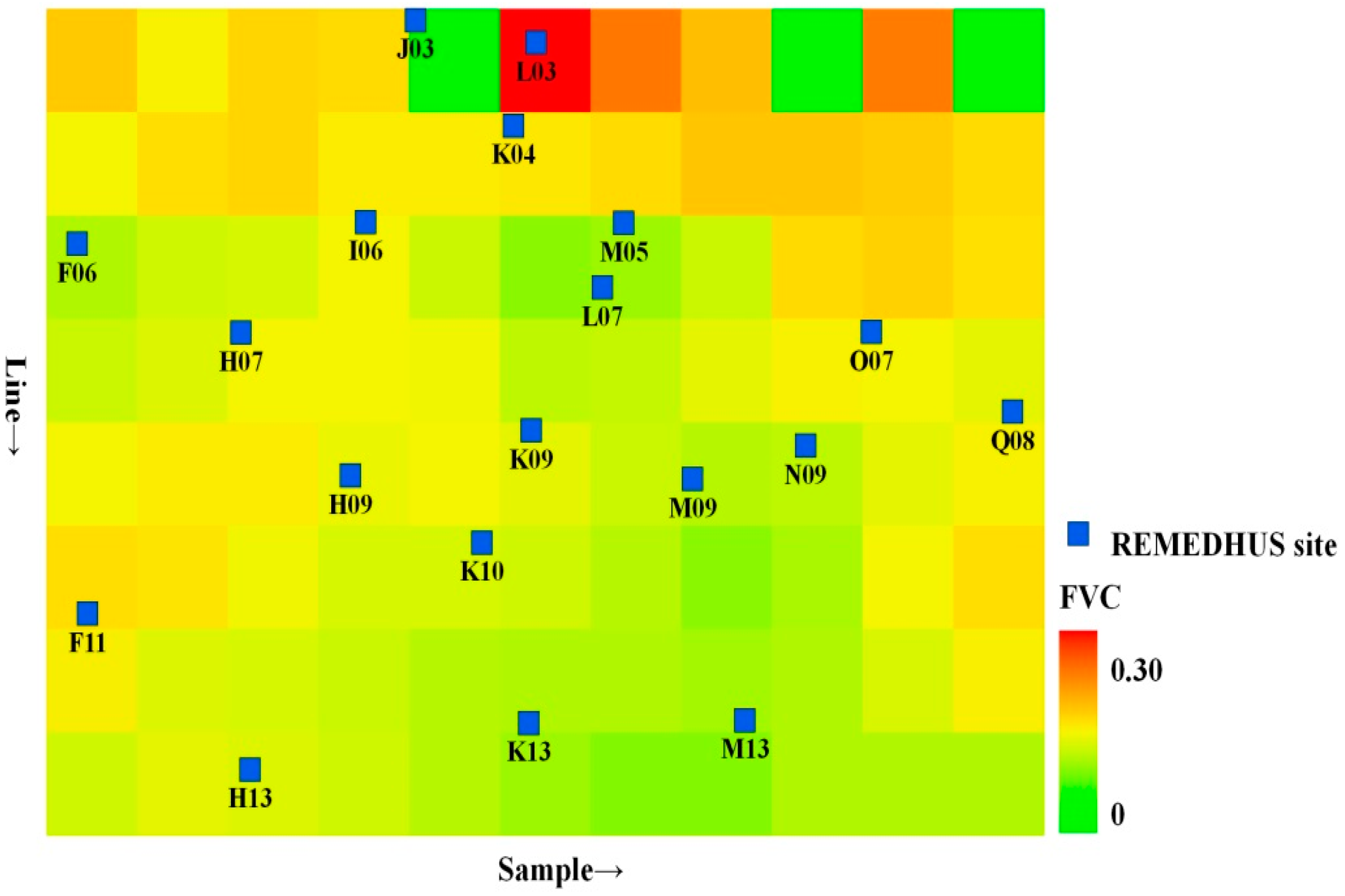
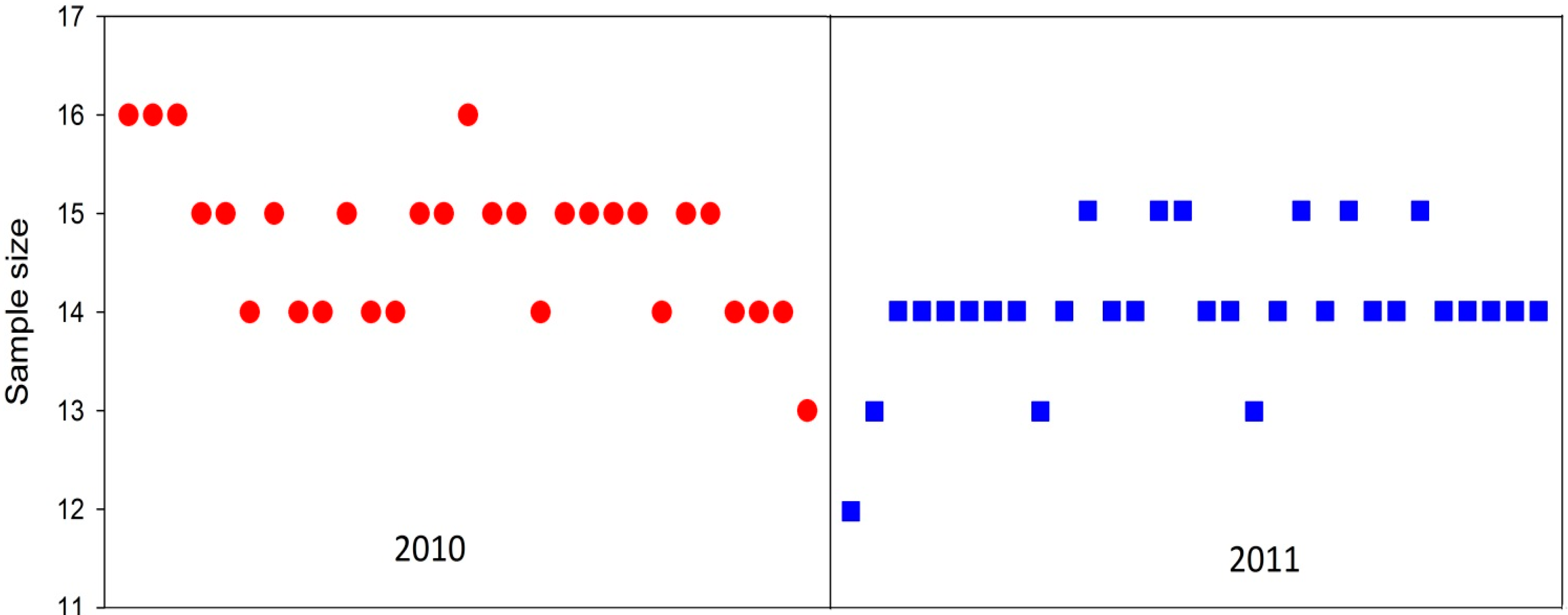

4.4. Surface Soil Moisture Retrieval and Preliminary Validation
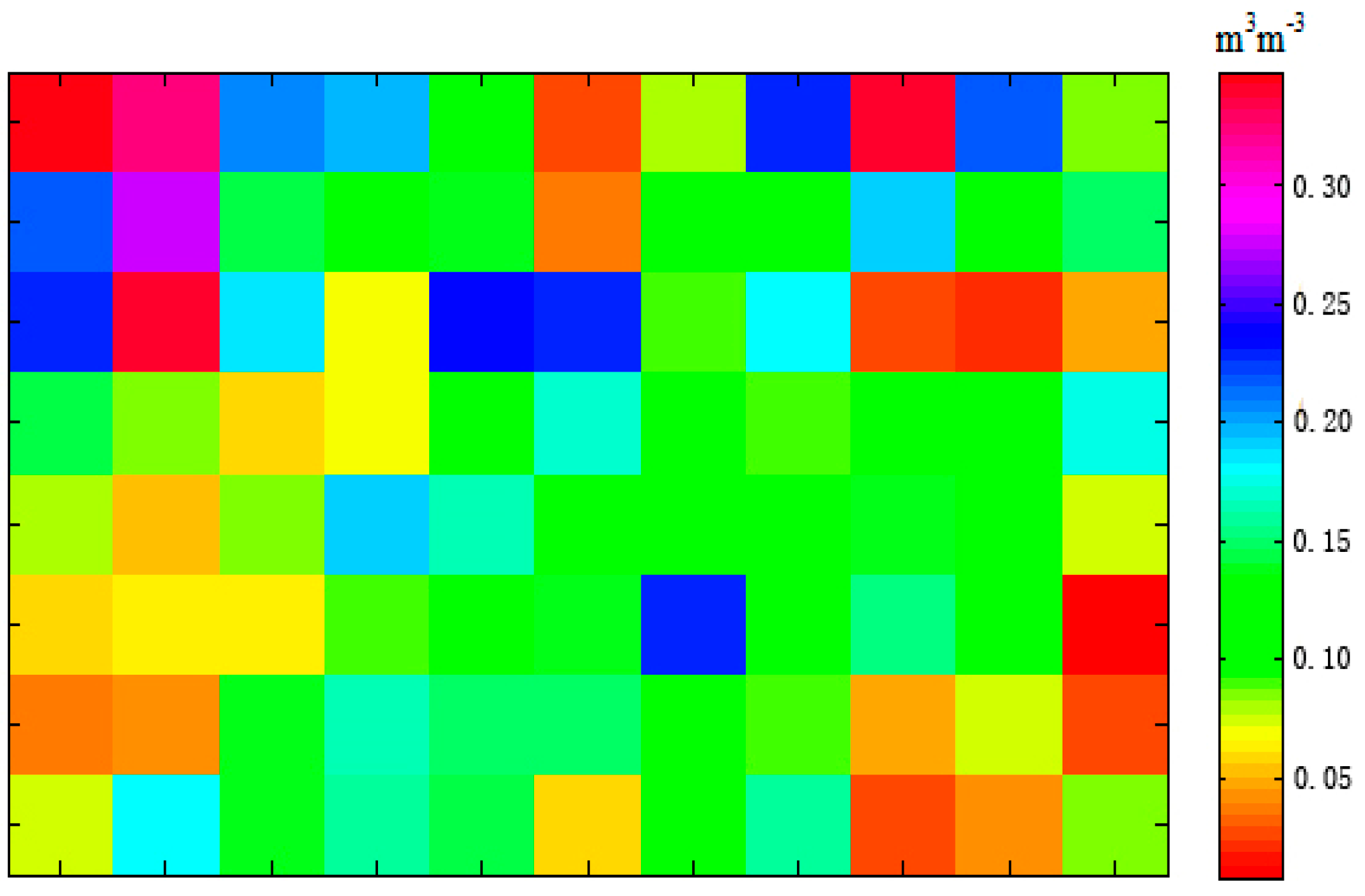
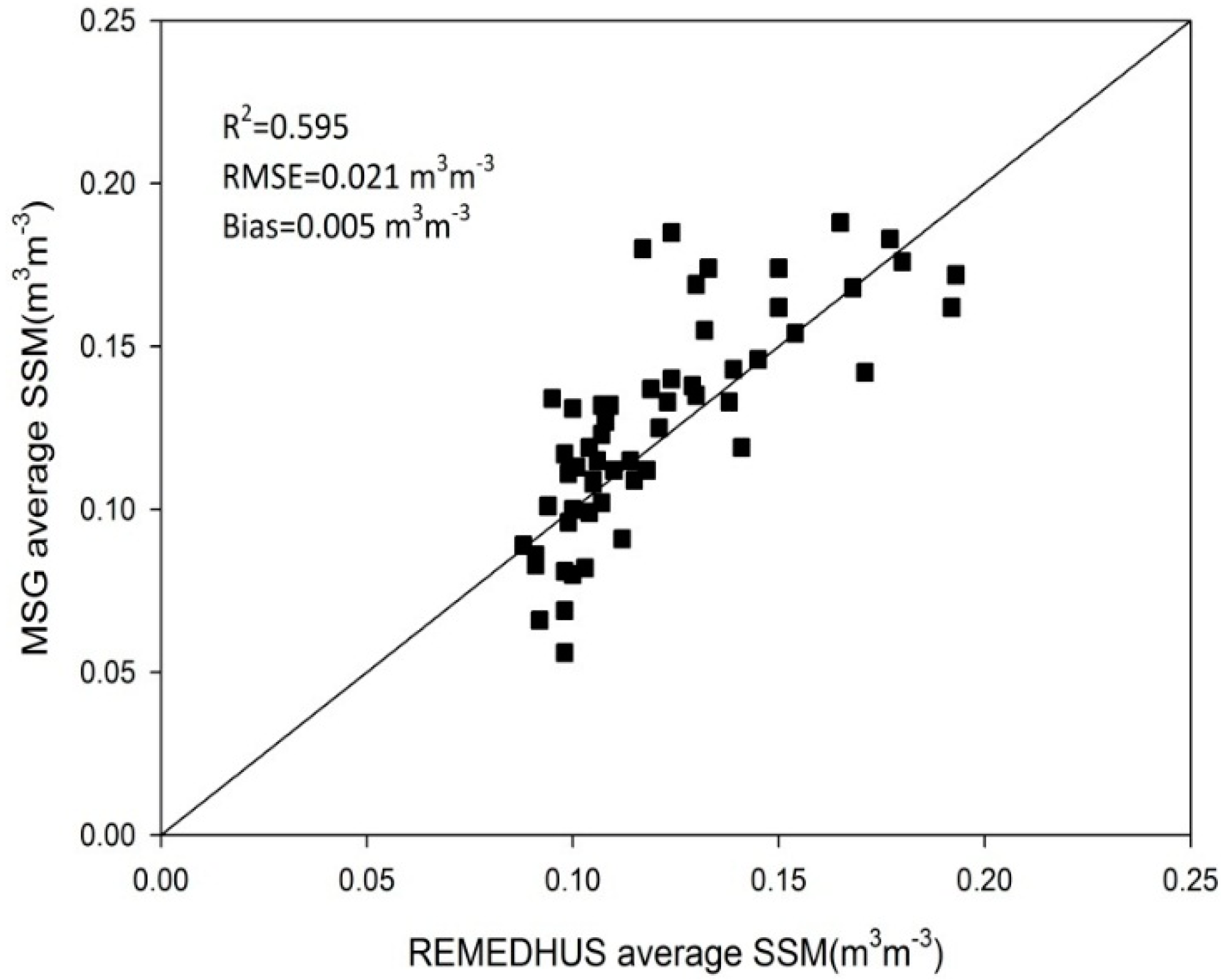
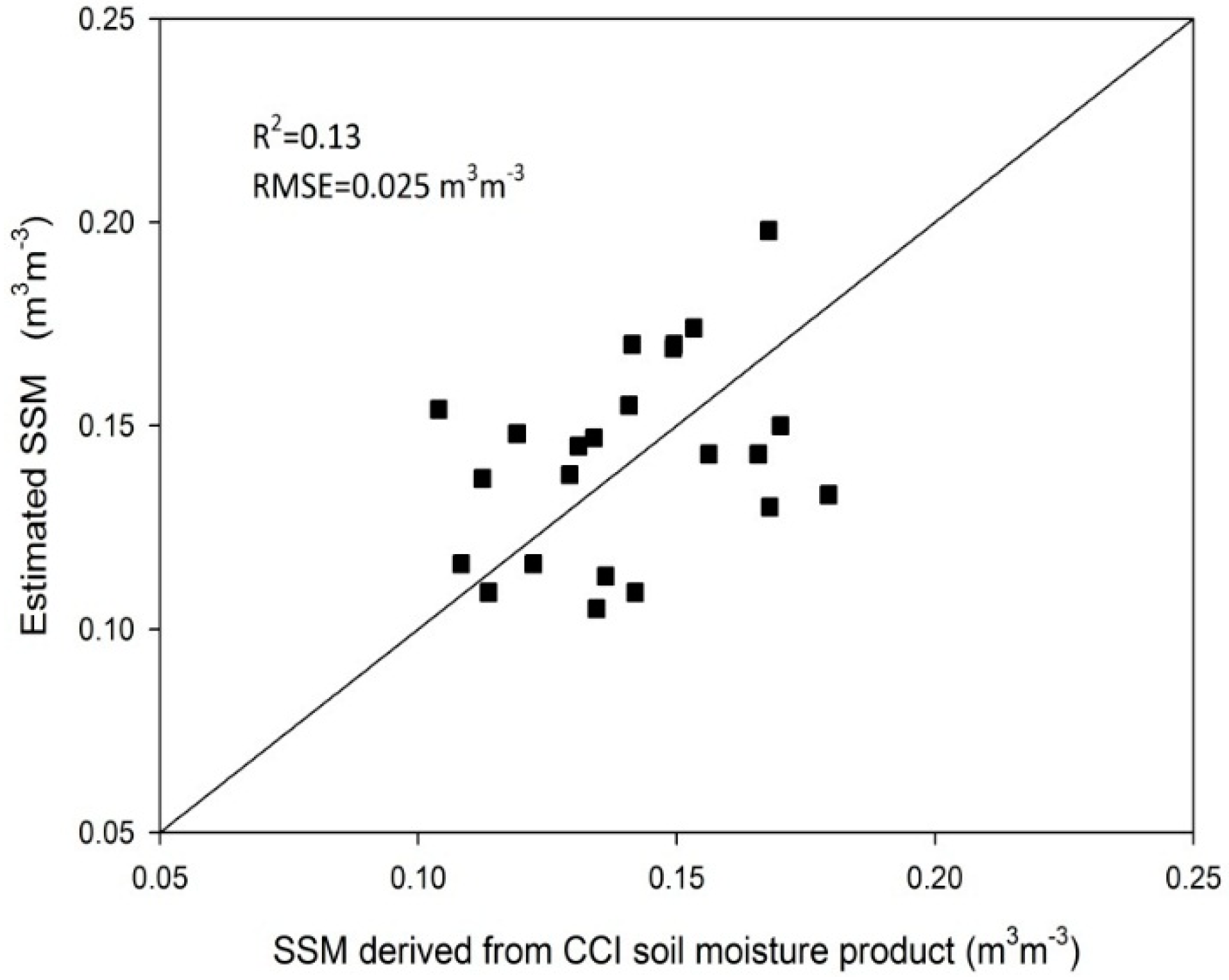
4.5. Prospects of the Surface Soil Moisture Retrieval Model
5. Conclusions
Acknowledgments
Author Contributions
Conflicts of Interest
Appendix
| Line | Sample | x0 | y0 | a | b | θ |
|---|---|---|---|---|---|---|
| 474 | 160 | 0.5072 | 0.2835 | 0.4929 | 0.0998 | 0.8997 |
| 474 | 161 | 0.5012 | 0.2948 | 0.4781 | 0.0949 | 0.9201 |
| 474 | 162 | 0.5643 | 0.3468 | 0.3988 | 0.0815 | 0.8571 |
| 474 | 163 | 0.5121 | 0.2693 | 0.4919 | 0.0891 | 0.8519 |
| 474 | 164 | 0.5665 | 0.3251 | 0.4030 | 0.0882 | 0.8672 |
| 474 | 165 | 0.5692 | 0.3543 | 0.3486 | 0.0920 | 0.9170 |
| 474 | 166 | 0.5340 | 0.3469 | 0.3639 | 0.0837 | 0.9885 |
| 474 | 167 | 0.5800 | 0.4084 | 0.3297 | 0.0775 | 0.9038 |
| 474 | 168 | 0.5237 | 0.3274 | 0.4455 | 0.0886 | 0.9003 |
| 474 | 169 | 0.5405 | 0.3480 | 0.3931 | 0.0861 | 0.9328 |
| 474 | 170 | 0.5951 | 0.4016 | 0.3040 | 0.0789 | 0.9138 |
| 475 | 160 | 0.6117 | 0.4203 | 0.3253 | 0.0819 | 0.8063 |
| 475 | 161 | 0.5702 | 0.3749 | 0.3796 | 0.0842 | 0.8654 |
| 475 | 162 | 0.5515 | 0.3146 | 0.4327 | 0.0802 | 0.8227 |
| 475 | 163 | 0.6199 | 0.3897 | 0.3318 | 0.0784 | 0.8043 |
| 475 | 164 | 0.4897 | 0.2275 | 0.5337 | 0.0959 | 0.8413 |
| 475 | 165 | 0.5534 | 0.3060 | 0.4167 | 0.0939 | 0.8504 |
| 475 | 166 | 0.5835 | 0.3457 | 0.3675 | 0.0859 | 0.8991 |
| 475 | 167 | 0.6162 | 0.4106 | 0.3041 | 0.0823 | 0.8676 |
| 475 | 168 | 0.5346 | 0.2985 | 0.4371 | 0.0928 | 0.9232 |
| 475 | 169 | 0.5802 | 0.3463 | 0.3709 | 0.0805 | 0.8844 |
| 475 | 170 | 0.5507 | 0.2911 | 0.4406 | 0.0869 | 0.8766 |
| 476 | 160 | 0.6121 | 0.3825 | 0.3575 | 0.0777 | 0.8126 |
| 476 | 161 | 0.4251 | 0.1674 | 0.6484 | 0.0897 | 0.8404 |
| 476 | 162 | 0.5404 | 0.2838 | 0.4796 | 0.0795 | 0.7862 |
| 476 | 163 | 0.5939 | 0.3485 | 0.3807 | 0.0805 | 0.7794 |
| 476 | 164 | 0.4297 | 0.1618 | 0.6455 | 0.0942 | 0.8003 |
| 476 | 165 | 0.3563 | 0.0454 | 0.7726 | 0.1043 | 0.8423 |
| 476 | 166 | 0.6293 | 0.3802 | 0.3374 | 0.0750 | 0.7847 |
| 476 | 167 | 0.5240 | 0.2685 | 0.4897 | 0.0885 | 0.8293 |
| 476 | 168 | 0.5773 | 0.3424 | 0.3748 | 0.0777 | 0.8350 |
| 476 | 169 | 0.5375 | 0.2906 | 0.4335 | 0.0799 | 0.8601 |
| 476 | 170 | 0.6128 | 0.3768 | 0.3268 | 0.0791 | 0.8487 |
| 477 | 160 | 0.5485 | 0.2996 | 0.4447 | 0.0833 | 0.8317 |
| 477 | 161 | 0.5791 | 0.3410 | 0.3885 | 0.0758 | 0.8155 |
| 477 | 162 | 0.5927 | 0.3458 | 0.3770 | 0.0756 | 0.8020 |
| 477 | 163 | 0.6110 | 0.3578 | 0.3573 | 0.0794 | 0.8083 |
| 477 | 164 | 0.6124 | 0.3662 | 0.3546 | 0.0815 | 0.8050 |
| 477 | 165 | 0.5737 | 0.3060 | 0.4333 | 0.0832 | 0.8164 |
| 477 | 166 | 0.6054 | 0.3371 | 0.3805 | 0.0795 | 0.8271 |
| 477 | 167 | 0.6195 | 0.3736 | 0.3439 | 0.0730 | 0.7998 |
| 477 | 168 | 0.5570 | 0.2995 | 0.4296 | 0.0830 | 0.8455 |
| 477 | 169 | 0.5445 | 0.2827 | 0.4541 | 0.0824 | 0.8534 |
| 477 | 170 | 0.4421 | 0.1582 | 0.6187 | 0.0949 | 0.8616 |
| 478 | 160 | 0.5487 | 0.3056 | 0.4228 | 0.0809 | 0.8623 |
| 478 | 161 | 0.5534 | 0.3160 | 0.4134 | 0.0795 | 0.8372 |
| 478 | 162 | 0.4654 | 0.2133 | 0.5550 | 0.0862 | 0.8256 |
| 478 | 163 | 0.5473 | 0.2779 | 0.4662 | 0.0861 | 0.8482 |
| 478 | 164 | 0.5659 | 0.3048 | 0.4291 | 0.0881 | 0.8500 |
| 478 | 165 | 0.5828 | 0.3297 | 0.4020 | 0.0871 | 0.8203 |
| 478 | 166 | 0.6295 | 0.3598 | 0.3512 | 0.0801 | 0.8093 |
| 478 | 167 | 0.6203 | 0.3470 | 0.3709 | 0.0783 | 0.7995 |
| 478 | 168 | 0.6082 | 0.3383 | 0.3881 | 0.0805 | 0.7962 |
| 478 | 169 | 0.6196 | 0.3635 | 0.3585 | 0.0780 | 0.7887 |
| 478 | 170 | 0.5866 | 0.3411 | 0.3863 | 0.0781 | 0.8020 |
| 479 | 160 | 0.5292 | 0.2973 | 0.4266 | 0.0839 | 0.8688 |
| 479 | 161 | 0.5716 | 0.3373 | 0.3837 | 0.0805 | 0.8509 |
| 479 | 162 | 0.6002 | 0.3711 | 0.3491 | 0.0764 | 0.8130 |
| 479 | 163 | 0.5647 | 0.3199 | 0.4099 | 0.0855 | 0.8350 |
| 479 | 164 | 0.5267 | 0.2606 | 0.4819 | 0.0873 | 0.8428 |
| 479 | 165 | 0.5700 | 0.3015 | 0.4345 | 0.0847 | 0.8179 |
| 479 | 166 | 0.5026 | 0.2212 | 0.5573 | 0.0866 | 0.7930 |
| 479 | 167 | 0.5943 | 0.3159 | 0.4158 | 0.0821 | 0.7677 |
| 479 | 168 | 0.5060 | 0.2348 | 0.5296 | 0.0881 | 0.8072 |
| 479 | 169 | 0.5604 | 0.3084 | 0.4299 | 0.0793 | 0.8281 |
| 479 | 170 | 0.6033 | 0.3663 | 0.3384 | 0.0771 | 0.8344 |
| 480 | 160 | 0.5951 | 0.3741 | 0.3257 | 0.0821 | 0.8933 |
| 480 | 161 | 0.6016 | 0.3923 | 0.3185 | 0.0743 | 0.8477 |
| 480 | 162 | 0.5837 | 0.3541 | 0.3753 | 0.0737 | 0.8456 |
| 480 | 163 | 0.5081 | 0.2420 | 0.5120 | 0.0889 | 0.8561 |
| 480 | 164 | 0.6017 | 0.3441 | 0.3871 | 0.0787 | 0.8016 |
| 480 | 165 | 0.5917 | 0.3180 | 0.4194 | 0.0812 | 0.7794 |
| 480 | 166 | 0.6168 | 0.3501 | 0.3773 | 0.0795 | 0.7690 |
| 480 | 167 | 0.5629 | 0.2926 | 0.4410 | 0.0819 | 0.8079 |
| 480 | 168 | 0.6196 | 0.3632 | 0.3329 | 0.0775 | 0.8190 |
| 480 | 169 | 0.5974 | 0.3470 | 0.3678 | 0.0765 | 0.8335 |
| 480 | 170 | 0.5805 | 0.3442 | 0.3719 | 0.0780 | 0.8359 |
| 481 | 160 | 0.5968 | 0.3844 | 0.3253 | 0.0779 | 0.8775 |
| 481 | 161 | 0.5251 | 0.3024 | 0.4472 | 0.0788 | 0.8822 |
| 481 | 162 | 0.5560 | 0.3279 | 0.4156 | 0.0776 | 0.8322 |
| 481 | 163 | 0.5597 | 0.3172 | 0.4337 | 0.0763 | 0.8005 |
| 481 | 164 | 0.5455 | 0.2972 | 0.4596 | 0.0776 | 0.7863 |
| 481 | 165 | 0.6492 | 0.3912 | 0.3175 | 0.0765 | 0.7645 |
| 481 | 166 | 0.6119 | 0.3539 | 0.3705 | 0.0758 | 0.7879 |
| 481 | 167 | 0.5024 | 0.2277 | 0.5339 | 0.0878 | 0.8264 |
| 481 | 168 | 0.5826 | 0.3212 | 0.3955 | 0.0754 | 0.8139 |
| 481 | 169 | 0.6396 | 0.3984 | 0.3049 | 0.0677 | 0.7613 |
| 481 | 170 | 0.6107 | 0.3766 | 0.3485 | 0.0741 | 0.7877 |
References
- Eltahir, E. A soil moisture-rainfall feedback mechanism, 1. Theory and observations. Water Resour. Res. 1998, 34, 765–776. [Google Scholar] [CrossRef]
- Entekhabi, D.; Rodriquez-Iturbe, I. Analytical framework for the characterization of the space-time variability of soil moisture. Adv. Water Resour. 1994, 17, 35–45. [Google Scholar] [CrossRef]
- Mintz, Y.; Serafini, Y. A global monthly climatology of soil moisture and water balance. Clim. Dyn. 1992, 8, 13–27. [Google Scholar] [CrossRef]
- Gokmen, M.; Vekerdy, Z.; Verhoef, A.; Verhoef, W.; Batelaan, O.; van der Tol, C. Integration of soil moisture in SEBS for improving evapotranspiration estimation under water stress conditions. Remote Sens. Environ. 2012, 121, 261–274. [Google Scholar] [CrossRef]
- Seneviratne, S.; Corti, T.; Davin, E.; Hirschi, M.; Jaeger, E.; Lehner, I.; Orlowsky, B.; Teuling, A. Investigating soil moisture-climate interactions in changing climate: A Review. Earth-Sci. Rev. 2010, 99, 125–161. [Google Scholar] [CrossRef]
- Szép, I.; Mika, J.; Dunkel, Z. Palmer drought severity index as soil moisture indicator: Physical interpretation, statistical behaviour and relation to global climate. Phys. Chem. Earth. 2005, 30, 231–243. [Google Scholar] [CrossRef]
- Krishnan, P.; Black, A.; Grant, J.; Barr, G.; Hogg, H.; Jassal, S.; Morgenstern, K. Impact of changing soil moisture distribution on net ecosystem productivity of boreal aspen forest during and following drought. Agric. For. Meteorol. 2006, 139, 208–223. [Google Scholar] [CrossRef]
- Qian, B.; Jong, R.; Gameda, S. Multivariate analysis of water-related agroclimatic factors limiting spring wheat yields on the Canadian prairies. Eur. J. Agron. 2009, 30, 140–150. [Google Scholar] [CrossRef]
- Hupet, F.; Vanclooster, M. Intraseasonal dynamics of soil moisture variability within a small agricultural maize cropped field. J. Hydrol. 2002, 261, 86–101. [Google Scholar] [CrossRef]
- Champagne, C.; Berg, A.A.; McNairn, H.; Drewitt, G.; Huffman, T. Evaluation of soil moisture extremes for agricultural productivity in the Canadian prairies. Agric. For. Meteorol. 2012, 165, 1–11. [Google Scholar] [CrossRef]
- Porporato, A.; D’Odorico, P.; Laio, F.; Rodriquez-Iturbe, I. Hydrologic controls on soil carbon and nitrogen cycles. I. Modeling scheme. Adv. Water Resour. 2003, 26, 45–58. [Google Scholar] [CrossRef]
- Yurova, A.Y.; Lankreijer, H. Carbon storage in the organic layers of boreal forest soils under various moisture conditions: A model study for northern Sweden sites. Ecol. Model. 2007, 204, 475–484. [Google Scholar] [CrossRef]
- Njoku, E.G.; Jackson, T.J.; Lakshmi, V.; Chan, T.K.; Nghiem, S.V. Soil moisture retrieval from AMSR-E. IEEE Trans. Geosci. Remote Sens. 2003, 41, 215–229. [Google Scholar] [CrossRef]
- Kerr, Y.H.; Waldteufel, P.; Wigneron, J.P.; Martinuzzi, J.; Font, J.; Berger, M. Soil moisture retrieval from space: The Soil Moisture and Ocean Salinity (SMOS) mission. IEEE Trans. Geosci. Remote Sens. 2001, 39, 1729–1735. [Google Scholar] [CrossRef]
- Entekhabi, D.; Njoku, E.G.; O’Neill, P.E.; Kellogg, K.H.; Crow, W.T.; Edelstein, W.N.; Entin, J.K.; Goodman, S.D.; Jackson, T.J.; Johnson, J.; et al. The Soil Moisture Active Passive (SMAP) mission. Proc. IEEE 2010, 98, 704–716. [Google Scholar] [CrossRef]
- Njoku, E.G.; Entekhabi, D. Passive microwave remote sensing of soil moisture. J. Hydrol. 1996, 184, 101–129. [Google Scholar] [CrossRef]
- Wigneron, J.P.; Calvetb, J.C.; Pellarinb, T.; Van de Griendc, A.A.; Bergerd, M.; Ferrazzolie, P. Retrieving near-surface soil moisture from microwave radiometric observations: Current status and future plans. Remote Sens. Environ. 2003, 85, 489–506. [Google Scholar] [CrossRef]
- Carlson, T. An overview of the “Triangle Method” for estimating surface evapotranspiration and soil moisture from satellite imagery. Sensors 2007, 7, 1612–1629. [Google Scholar] [CrossRef]
- Wang, L.; Qu, J. Satellite remote sensing applications for surface soil moisture monitoring: A review. Front. Earth Sci. 2009, 3, 237–247. [Google Scholar] [CrossRef]
- Petropoulos, G.; Carlson, T.; Wooster, M.J.; Islam, S. A review of Ts/VI remote sensing based methods for the retrieval of land surface energy fluxes and soil surface moisture. Prog. Phys. Geogr. 2009, 33, 224–250. [Google Scholar] [CrossRef]
- Li, Z.-L.; Tang, R.L.; Wan, Z.; Bi, Y.; Zhou, C.; Tang, B.H.; Yan, G.; Zhang, X. A review of current methodologies for regional evapotranspiration estimation from remotely sensed data. Sensors 2009, 9, 3801–3853. [Google Scholar] [CrossRef] [PubMed]
- Li, Z.-L.; Tang, B.H.; Wu, H.; Ren, H.; Yan, G.; Wan, Z. Satellite-derived land surface temperature: Current status and perspectives. Remote Sens. Environ. 2013, 131, 14–37. [Google Scholar] [CrossRef]
- Li, Z.-L.; Wu, H.; Wang, N.; Qiu, S.; Sobrino, J.A.; Wan, Z.M.; Tang, B.H.; Yan, G.J. Land surface emissivity retrieval from satellite data. Int. J. Remote Sens. 2013, 34, 3084–3127. [Google Scholar] [CrossRef]
- Price, J.C. The potential of remotely sensed thermal infrared data to infer surface soil moisture and evaporation. Water Resour. Res. 1980, 16, 787–795. [Google Scholar] [CrossRef]
- Verstraeten, W.; Veroustraete, F.; Sande, C.; Grootaers, I.; Feyen, J. Soil moisture retrieval using thermal inertia, determined with visible and thermal spaceborne data, validated for European forests. Remote Sens. Environ. 2006, 101, 299–314. [Google Scholar] [CrossRef]
- Minacapilli, M.; Iovino, M.; Blanda, F. High resolution remote estimation of soil surface water content by a thermal inertia approach. J. Hydrol. 2009, 379, 229–238. [Google Scholar] [CrossRef]
- Davies, J.; Allen, C. Equilibrium, potential and actual evaporation from cropped surfaces in southern Ontario. J. Appl. Meteorol. 1973, 12, 649–657. [Google Scholar] [CrossRef]
- Sandholt, I.; Rasmussen, K.; Andersen, J. A simple interpretation of the surface temperature/vegetation index space for assessment of surface moisture status. Remote Sens. Environ. 2002, 79, 213–224. [Google Scholar] [CrossRef]
- Leng, P.; Song, X.; Li, Z.-L.; Ma, J.; Zhou, F.; Li, S. Bare surface soil moisture retrieval from the synergistic use of optical and thermal infrared data. Int. J. Remote Sens. 2014, 35, 988–1003. [Google Scholar] [CrossRef]
- Leng, P.; Song, X.; Li, Z.-L.; Wang, Y. Evaluation of the effects of soil layer classification in the common land model on modeled surface variables and the associated land surface soil moisture retrieval model. Remote Sens. 2013, 5, 5514–5529. [Google Scholar] [CrossRef]
- Ceballos, A.; Scipal, K.; Wagner, W.; Martínez-Fernández, J. Validation of ERS scatterometer-derived soil moisture data in the central part of the Duero basin, Spain. Hydrol. Process. 2005, 19, 1549–1566. [Google Scholar] [CrossRef]
- Wanger, W.; Naeimi, V.; Scipal, K.; de Jeu, R.; Martínez-Fernández, J. Soil moisture from operational meteorological satellites. Hydrogeol. J. 2007, 15, 121–131. [Google Scholar] [CrossRef]
- Wanger, W.; Pathe, C.; Doubkova, M.; Sabel, D.; Bartsch, A.; Hasenauer, S.; Blöschl, G.; Scipal, K.; Martínez-Fernández, J.; Löw, A. Temporal stability of soil moisture and radar backscatter observed by the Advanced Synthetic Aperture Radar (ASAR). Sensors 2008, 8, 1174–1197. [Google Scholar]
- Sánchez, N.; Martínez-Fernández, J.; Scaini, A.; Pérez-Gutiérrez, C. Validation of the SMOS L2 soil moisture data in the REMEDHUS network (Spain). IEEE Trans. Geosci. Remote Sens. 2012, 50, 1602–1611. [Google Scholar] [CrossRef]
- International Soil Moisture Network. Available online: http://ismn.geo.tuwien.ac.at/ (accessed on 10 November 2014).
- Sánchez, N.; Martínez-Fernández, J.; Calera, A.; Torres, E.; Pérez-Gutiérrez, C. Combining remote sensing and in situ soil moisture data for the application and validation of a distributed water balance model (HIDROMORE). Agric. Water Manag. 2010, 98, 69–78. [Google Scholar] [CrossRef]
- Schmetz, J.; Pili, P.; Tjemkes, S.; Just, D.; Kerkmann, J.; Rota, S.; Ratier, A. An introduction to Meteosat Second Generation (MSG). Bull. Amer. Meteor. Soc. 2002, 83, 977–992. [Google Scholar] [CrossRef]
- Land Surface Analysis Satellite Applications Facility (LSA-SAF). Available online: http://landsaf.meteo.pt/ (accessed on 10 November 2014).
- Bonan, G.B. A Land Surface Model (LSM Version 1.0) for Ecological, Hydrological, and Atmospheric Studies: Technical Description and User’s Guide; NCAR Technical NoteNCAR/TN-417+STR; National Center for Atmospheric Research: Boulder, CO, USA, 1996; p. 150. [Google Scholar]
- The GEM Software Project. Available online: http://www.tonyohagan.co.uk/academic/GEM/ (accessed on 10 November 2014).
- Rahimzadeh-Bajgiran, P.; Berg, A.; Champagne, C.; Omasa, K. Estimation of soil moisture using optical/thermal infrared remote sensing in the Canadian prairies. ISPRS J. Photogramm. 2013, 83, 94–103. [Google Scholar] [CrossRef]
- European Space Agency. Climate Change Initiatiue. Available online: http://www.esa-soilmoisture-cci.org/ (accessed on 10 November 2014).
© 2015 by the authors; licensee MDPI, Basel, Switzerland. This article is an open access article distributed under the terms and conditions of the Creative Commons Attribution license (http://creativecommons.org/licenses/by/4.0/).
Share and Cite
Leng, P.; Song, X.; Li, Z.-L.; Wang, Y.; Wang, R. Toward the Estimation of Surface Soil Moisture Content Using Geostationary Satellite Data over Sparsely Vegetated Area. Remote Sens. 2015, 7, 4112-4138. https://doi.org/10.3390/rs70404112
Leng P, Song X, Li Z-L, Wang Y, Wang R. Toward the Estimation of Surface Soil Moisture Content Using Geostationary Satellite Data over Sparsely Vegetated Area. Remote Sensing. 2015; 7(4):4112-4138. https://doi.org/10.3390/rs70404112
Chicago/Turabian StyleLeng, Pei, Xiaoning Song, Zhao-Liang Li, Yawei Wang, and Ruixin Wang. 2015. "Toward the Estimation of Surface Soil Moisture Content Using Geostationary Satellite Data over Sparsely Vegetated Area" Remote Sensing 7, no. 4: 4112-4138. https://doi.org/10.3390/rs70404112




